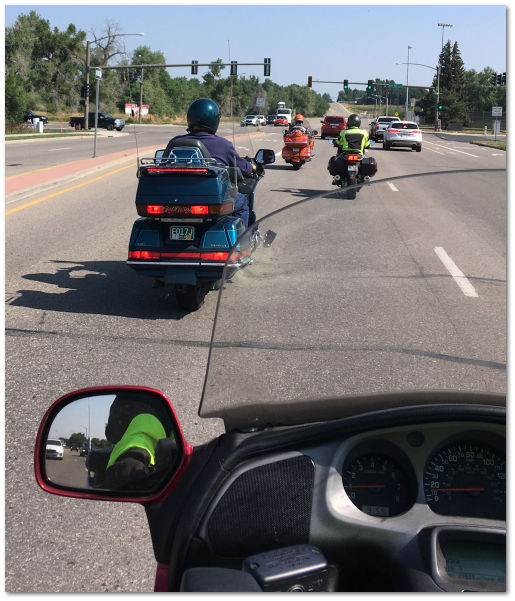Group Riding
This article was written by Vic Wheeler and with his permission, I'm sharing it here. It's a wonderful read and full of good information. Thank you for allowing me to post it here.

October 2021 — by Victor Wheeler ~ ( Webmaster Colorado District )
Most of the motorcycle riders we know engage in group rides because they are fun. The co-motion among a number of riders tends to generate a feeling of camaraderie and teamwork. Such a feeling within a group compares with warm feelings among family members, and in this author's opinion, this is what makes group riding so rewarding.
Supporting that purpose, we use the following guidelines to maximize the fun we have. (Note: I use the term "fun" as an "umbrella term" which necessarily includes safety. Reason: "fun" always includes the concept of everyone getting to the destination happy and in one piece.) Here they are.
Safety is top priority for every rider in group rides. Each rider is responsible for the safety of himself and his co-rider. It is every rider’s responsibility to ‘ride their own ride’, sometimes outside of the guidance of the lead. Personal safety with respect to personal skill level and experience is always primary. Thus, this guideline applies to all situations, all maneuvers, and all decisions while we are on the road, whether we have a "standard procedure" or not. This is a thousand times more important than yielding to peer pressure, trying to rush, or otherwise putting yourself or others in a dangerous situation.
- If any planned maneuver appears unsafe, then use safe judgement and drive accordingly.
- Set a good example.
- Be polite to other drivers on the road.
The Lead Rider's responsibility is to lead the group and keep it together where feasible and safe. Towards this end, the Lead normally rides at a speed that accommodates the skill and comfort levels of the other riders in the group.
The rider at the back of the group is the "Tail" (or "Tail Gunner"). The Tail's responsibility is the safety of the group. The Lead selects the Tail before the ride.
Prior to the ride beginning, the Lead will set expectations and discuss the route and any planned stops. If you have suggestions, needs, medical conditions the Lead and/or others should know about, or any other concerns, this is the time to voice them. Once the riders know the plan, then the Lead has people pair up and do last-minute light checks, tire kicks, and a radio check, before the group departs.
If no other formation has been called for, we normally ride in staggered formation. In this formation the Lead rides in the left tire track, the next rider on the right, and so on. On curves, the rider may pick his own track and then reform in staggered formation after the curve. Staggered formation normally looks like this:
When stopping at a traffic light or stop sign, the formation tightens up, but should retain the staggered form so that the Lead (and each rider) retains a clear view of both left and right sides when proceeding into the intersection.
So that the Lead's speed is predictable (and so you can set your cruise control by it), the Lead will usually drive the speed limit. (Most Leads this author knows use GPS speed rather than "indicated" speed, but this choice is entirely up to the Lead.)
If the Lead makes a wrong turn, or misses a turn, stick with him. (Making the "correct" turn and splitting the group up creates unwanted confusion.)
It is easy for riders to get their focus stuck on the motorcycle ahead of you. However, the safest situation is when each rider is aware of the road, traffic, and circumstances for about 12-seconds ahead of where he is. With one's attention thus adjusted, peripheral vision is frequently used to gauge distance to the motorcycle ahead of you. This gets easier with practice.
When passing other vehicles on a two-lane highway, each bike should pass one at a time. After passing, put enough clear distance behind you to allow the next rider to pass. The Tail will inform the Lead when the whole group has passed and the group is back together again.
When you see hand signals, "pass them back" by repeating them so the person behind you can see them too. These including pointing out debris or hazards on the road. The Lead will try to point these out when he can.
In curvy areas, or in a variety of situations where forward visibility and/or traction is limited, the Lead will signal with 1 finger. This means "single file". Spread out and put at least 2 seconds between you and the rider in front of you. Use the full width of the lane the way you normally would when riding alone. In most situations, you are positioning yourself to maximize the number of choices you have, moment to moment, with visibility to other drivers being among the many factors involved. Especially, make enough room so you can see debris on the road. (While the Lead will try to point out debris, your eyes are always going to be faster and more reliable.)
The hand signal using 2 fingers is a call to ride in staggered formation. This shortens up the length of the group, and encourages other drivers on the road to treat the group as a "unit" and not pull out into traffic (e.g. from a side road) or change lanes in a way that separates us.
If we get aggressive traffic coming up behind us wanting (or needing) to pass, the Tail notifies the Lead by radio. On a freeway, this is cared for by splitting into groups of 4-5 each. On a two-lane highway, Lead will signal single file (1 finger). This means make some wide gaps so that the passing vehicle only has to pass one motorcycle at a time. Safe judgement and helping the passer to safely get around comes into play here, especially if oncoming traffic is heavy.
If the Lead stands up, it is not a signal. He is simply taking the weight off his gluts for a bit.
In merging onto a freeway, we DO NOT do it as a group. Instead, we spread WAY out with BIG GAPS BETWEEN MOTORCYCLES so as to make it as easy as possible for each rider to adjust speed and fit into traffic.
Once the group is all on the freeway, the Lead may slow down a bit so as to encourage intervening vehicles to pass. If an intervening vehicle does not want to pass, then go ahead and pass it in a safe manner so as to eventually get the group back together again. This is a place where safe judgement will be called for.
Optionally, depending on needs and traffic circumstances, the Lead may call for the Tail to secure a lane, and soon after call for a lane change into a now-secured-and-clear lane to both re-join the group together, and secure a faster lane. It is entirely up to the Lead and his judgement of needs and circumstances whether to do this or not.
Lane Changes: When safe, we do group lane changes in a way that is fun and even thrilling to experience: synchronized. Safety is primary, so if last-minute circumstances indicate it is safer to delay switching lanes, then by all means make the safe choice. (This is true for any maneuver.) Keeping that in mind, when synchronized lane changing is done well, it can be beautiful to witness.
This is how it generally goes (on CB radio, using LEFT as an example—it works the same for RIGHT):
- Lead asks Tail to secure left lane.
- Tail secures lane and announces, "Left lane secure."
- Lead announces, "Turn signals on. Look left. Go left." and the group changes lanes in unison.
Note 1: The reason for the announcement of turn signals is that in heavy traffic, where securing the left lane is needed in order to open up a space to move into, turning on turn signals early might encourage cars in the process of going around us to stop going around us thinking they are being "polite" by letting us change lanes, when in fact we want them to pass us. This coordination prevents that confusion in heavy traffic.
Note 2: If we are in staggered formation, riders farthest from target lane should not cross paths with the riders nearest the target lane.
Be aware of your environment. When lane changes are likely, it is a time to keep CB chatter to a minimum so as to allow Lead and Tail to coordinate by radio.
If a motorcycle breaks down or otherwise needs to pull off and stop, do not follow. The Tail Gunner will stay with them, and the Lead takes the rest of the group on to the next place where it is safe for the whole group to pull off, park, and otherwise coordinate actions with the Tail.
At the end of a ride, riders sometimes need to split off from the group while the group is rolling, to head to their next destination. The normal method of doing this is, when feasible and safe, a mile or two before splitting off, do a wave-around (from a different lane if possible), putting the Tail Gunner ahead of you so you're at the back. Then split off from the rear. The riders remaining in the group then re-form the formation by filling the gaps. This maximizes the number of choices the rider has when splitting off, and allows him to make any adjustments necessary during this phase of his trip without causing confusion in the group. This is especially helpful in heavy traffic or on a 2-lane highway. In light traffic or where multiple lanes are available, this becomes less important, but is often still helpful.
While these are only guidelines, they have been won by long years of experience in group riding, and are aimed at making group rides as rewarding as they can be. The fun and camaraderie generated by group riding is the reason most of us are here.
Goodness knows this knowledge is ever evolving, so comments and feedback are welcome.
Happy trails!
—Victor Wheeler
